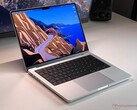A new video from YouTube channel Blendlogic Tech showcases how far Apple Silicon Macs have come as gaming machines. Running games via Crossover, the creator tested a range of titles on an M1 Max MacBook Pro, using macOS 26 “Tahoe”, Metal 4, and the latest Game Porting Toolkit 3.0 (auto beta 1). Notably, Black Myth: Wukong, Hogwarts Legacy, and The Witcher 3 all hit or exceed 60 FPS under the right configurations.
For readers unfamiliar with how features like DLSS, Metal FX, and frame generation operate on macOS, these have been explained in a separate article here.
Black Myth: Wukong appeared to perform well in Blendlogic Tech’s testing, with DLSS delivering frame rates around 70 FPS. The creator said that the game ran smoothly under Nvidia’s upscaling, while AMD FSR lagged behind. Issues like untranslated menus and inconsistent frame generation hindered the gameplay, but it was difficult to identify the root cause, they said. The YouTuber also speculated that newer Apple chips like the M2 could potentially deliver better results.
Hogwarts Legacy fared very well in testing. With DLSS enabled, the game reportedly started at around 45 FPS. Turning on frame generation nearly doubled performance to 90 FPS indoors and brought it close to 70–80 FPS in outdoor scenes. When switching to AMD FSR, performance dropped, averaging close to 40 FPS indoors and around 30 FPS outdoors, even with frame generation enabled. Based on these figures, the creator concluded that DLSS currently offers a more reliable upscaling experience on Apple silicon.
According to the YouTuber, The Witcher 3 loads under DX11, which currently prevents access to frame generation. Despite this, performance was strong in their testing. On low settings, the game reportedly exceeded 120 FPS, fully utilising the MacBook Pro’s 120 Hz ProMotion display. Even on ultra settings, with HairWorks disabled, it maintained a consistent 60 to 70 FPS.
Spider-Man Remastered proved more challenging to configure, based on testing shown in the YouTuber’s video. DLSS paired with Metal FX pushed performance to around 50 FPS, but turning on AMD’s frame generation brought it down to the low 40s. The option to combine DLSS with AMD FSR’s frame gen was explored as well, though this setup resulted in more frame drops, likely due to conflicting upscaling pipelines. Ultimately, the video suggests that the most reliable results came from using DLSS alone with frame generation turned off.
With GPTK 3.0, Metal 4, and Crossover working in tandem, Blendlogic Tech’s video paints a promising picture for Mac gaming. For Apple Silicon users willing to experiment with settings, 60 FPS gaming is now within reach on a growing number of titles. Even those that aren’t officially supported on Macs.
The YouTuber also explored a few other titles during testing, including Spider-Man 2, Armored Core 6, and Marvel Rivals. For a closer look at how these games fared and to see the complete performance breakdown, be sure to watch the full video linked below.



















